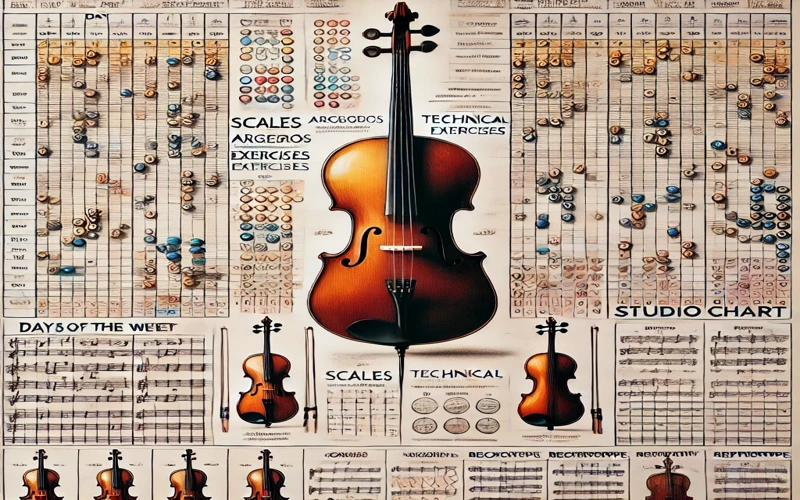What Does a Studio Chart for Cello Look Like?

A studio chart for cello is an organized tool designed to enhance a cellist’s practice sessions. These charts provide a visual guide for tracking progress across different technical and musical areas.
Whether the chart is used by a student, a teacher, or a professional musician, it offers structure to practice routines, ensuring comprehensive development in all necessary skills.
A studio chart for cello is often divided into several categories that cover different aspects of cello playing, from technical exercises to pieces of music, making it a versatile tool in any musician’s toolkit.
Components of a Studio Chart for Cello
Typically, a studio chart for cello is laid out in a tabular format, with rows and columns that represent various categories of practice and the days of the week, respectively. These components are detailed below:
Scales and Arpeggios
Scales and arpeggios are fundamental to every musician’s training, and for cellists, they are no exception. The chart will often dedicate a section to major, minor, and chromatic scales, spanning multiple octaves across different keys. These scales are practiced in a variety of rhythmic patterns and bowing techniques to ensure fluency and agility across the instrument.
Arpeggios, often practiced in conjunction with scales, are broken down into different inversions and keys, helping cellists develop smooth shifting between positions and strengthen their left-hand technique.
Technical Exercises
Technical exercises are essential for building strong foundations in cello playing. This section of the chart may list etudes or exercises from well-known methods like “Dotzauer,” “Popper,” or “Feuillard.” These etudes target specific technical challenges such as shifting, finger independence, vibrato, and string crossings.
For advanced players, the chart may include exercises that focus on bowing techniques like spiccato, staccato, legato, and col legno. This helps the player gain control over the bow while developing sound production and articulation.
Repertoire
One of the most critical sections in a studio chart for cello is the repertoire. Here, musicians track the pieces they are working on, from solo works to chamber music, orchestral excerpts, or even contemporary pieces. The repertoire section often breaks down pieces into movements or sections, allowing players to monitor their progress.
For example, a cellist might list Johann Sebastian Bach’s “Cello Suite No. 1” as part of their repertoire, with different sections such as the Prelude, Allemande, and Courante listed separately. This organization helps players focus on improving specific parts of the piece before tackling the whole work.
Daily Practice Schedule
The chart may also include a daily schedule, breaking down practice sessions into distinct sections such as warm-ups, technical work, repertoire practice, and cool-downs. This segmentation ensures that players dedicate time to all important aspects of cello playing without over-focusing on one area at the expense of others.
Many players structure their schedule based on the “practice sandwich” approach, where they begin with easier tasks like warm-ups, move on to more challenging technical exercises, then work on their repertoire, and finally, return to less demanding activities to wind down.
Goals and Milestones
Goal setting is a vital aspect of any musician’s practice. A cello studio chart typically includes a section for short-term and long-term goals. These goals might include mastering a particular technique, preparing for an audition, or learning an entire sonata.
Musicians might also set milestones such as learning a piece by heart, perfecting vibrato in a specific passage, or achieving a certain tempo in a challenging section. Tracking these goals provides motivation and a sense of accomplishment as they are achieved.
Ear Training and Music Theory
Advanced studio charts for cello might include sections for ear training and music theory. Ear training exercises might involve recognizing intervals, identifying chord progressions, or working on sight-singing melodies. Music theory could involve writing out key signatures, learning harmonic progressions, or analyzing the form of a piece.
This section ensures that cellists not only develop their technical and physical skills but also strengthen their aural and theoretical understanding of music, which is crucial for interpretation and expression.
Visual Design of a Studio Chart
A well-designed studio chart for cello practice often resembles a grid with each row representing a different category of practice (e.g., scales, arpeggios, technical exercises, etc.) and each column representing a day of the week.
It may feature colored markers, stickers, or icons that indicate completed tasks, tasks that need improvement, or areas that have been mastered. Some charts include small musical excerpts or notation to visually aid the practice session.
In a professional setting, a studio chart might be displayed on a large board in a practice room, where the cellist can make real-time updates after each session. Digital charts are also becoming popular, allowing musicians to track their progress on tablets or smartphones.
Why Use a Studio Chart?
The purpose of using a studio chart is to organize and balance a musician’s practice routine, especially when preparing for performances, auditions, or recording sessions. Cello players often face multiple challenges, from perfecting their technique to mastering the emotional nuances of a piece.
A studio chart helps them approach these challenges in an organized manner, ensuring that each area of their playing is developed in a balanced and structured way.
For beginners, studio charts provide a roadmap that guides them through the essential aspects of learning the cello. It helps them focus on areas that need improvement while also giving them a sense of progress as they mark off completed tasks.
For advanced players, the chart becomes a detailed log of their journey through more complex repertoire and techniques, helping them maintain a high level of artistry and technical precision.
Conclusion
A studio chart for cello is an indispensable tool for both novice and seasoned cellists. It offers structure, organization, and a clear path to improvement. By dividing practice into categories and tracking progress over time, musicians can ensure that they are covering all necessary aspects of their development.
From scales and arpeggios to repertoire and advanced techniques, a studio chart provides a visual roadmap that leads cellists toward musical mastery. Whether it’s on paper or in digital form, the studio chart becomes an invaluable companion on the musician’s journey.



